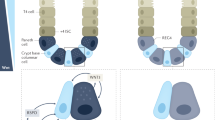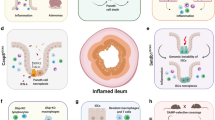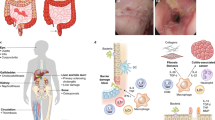Abstract
The pathogenesis of Crohn's disease and ulcerative colitis, the two major forms of inflammatory bowel disease, involves a complex interplay between certain genetic, environmental and immunological factors. Considerable research progress in the last decade defined key inflammatory pathways in the inflamed gut and identified new potential therapeutic targets. Since the current medical treatment with corticosteroids and anti-inflammatory drugs is often associated with undesired side effects and cannot completely cure IBD, these current advances in our understanding of intestinal pathology may now allow the development of new biologic treatment strategies including gene therapy. In this review, we will give a brief overview of potential gene therapy target molecules related to chronic intestinal inflammation. Furthermore, we summarize the results of recent preclinical studies for intestinal gene transfer and discuss future perspectives.
This is a preview of subscription content, access via your institution
Access options
Subscribe to this journal
Receive 12 print issues and online access
$259.00 per year
only $21.58 per issue
Buy this article
- Purchase on Springer Link
- Instant access to full article PDF
Prices may be subject to local taxes which are calculated during checkout

Similar content being viewed by others
References
Podolsky DK . Inflammatory bowel disease. N Engl J Med 2002; 347: 417–429.
Shanahan F . Crohn's disease. Lancet 2002; 359: 62–69.
Wirtz S, Neurath MF . Animal models of intestinal inflammation: new insights into the molecular pathogenesis and immunotherapy of inflammatory bowel disease. Int J Colorectal Dis 2000; 15: 144–160.
Blumberg RS, Strober W . Prospects for research in inflammatory bowel disease. JAMA 2001; 285: 643–647.
Sandborn WJ, Targan SR . Biologic therapy of inflammatory bowel disease. Gastroenterology 2002; 122: 1592–1608.
Fiocchi C . Intestinal inflammation: a complex interplay of immune and nonimmune cell interactions. Am J Physiol 1997; 273: G769–G775.
Fiocchi C . Inflammatory bowel disease: etiology and pathogenesis. Gastroenterology 1998; 115: 182–205.
Elson CO . Commensal bacteria as targets in Crohn's disease. Gastroenterology 2000; 119: 254–257.
Neurath MF, Finotto S, Glimcher LH . The role of Th1/Th2 polarization in mucosal immunity. Nat Med 2002; 8: 567–573.
Strober W, James SP . The immunologic basis of inflammatory bowel disease. J Clin Immunol 1986; 6: 415–432.
Strober W et al. Reciprocal IFN-gamma and TGF-beta responses regulate the occurrence of mucosal inflammation. Immunol Today 1997; 18: 61–64.
Hugot JP et al. Association of NOD2 leucine-rich repeat variants with susceptibility to Crohn's disease. Nature 2001; 411: 599–603.
Ogura Y et al. A frameshift mutation in NOD2 associated with susceptibility to Crohn's disease. Nature 2001; 411: 603–606.
Elson CO . Genes, microbes, and T cells – new therapeutic targets in Crohn's disease. N Engl J Med 2002; 346: 614–616.
Gutierrez O et al. Induction of Nod2 in myelomonocytic and intestinal epithelial cells via nuclear factor-kB activation. J Biol Chem 2002; 277: 41701–41705.
Plevy SE et al. A role for TNF-alpha and mucosal T helper-1 cytokines in the pathogenesis of Crohn's disease. J Immunol 1997; 159: 6276–6282.
Blam ME, Stein RB, Lichtenstein GR . Integrating anti-tumor necrosis factor therapy in inflammatory bowel disease: current and future perspectives. Am J Gastroenterol 2001; 96: 1977–1997.
Scallon B et al. Binding and functional comparisons of two types of tumor necrosis factor antagonists. J Pharmacol Exp Ther 2002; 301: 418–426.
van Deventer SJ . Transmembrane TNF-alpha, induction of apoptosis, and the efficacy of TNF-targeting therapies in Crohn's disease. Gastroenterology 2001; 121: 1242–1246.
Holtmann MH et al. Tumor necrosis factor-receptor 2 is up-regulated on lamina propria T cells in Crohn's disease and promotes experimental colitis in vivo. Eur J Immunol 2002; 32: 3142–3151.
Spahn TW et al. Mesenteric lymph nodes are critical for the induction of high-dose oral tolerance in the absence of Peyer's patches. Eur J Immunol 2002; 32: 1109–1113.
van Assche G, Rutgeerts P . Antiadhesion molecule therapy in inflammatory bowel disease. Inflamm Bowel Dis 2002; 8: 291–300.
Neurath MF et al. Antibodies to interleukin 12 abrogate established experimental colitis in mice. J Exp Med 1995; 182: 1281–1290.
Madsen SM et al. An open-labeled, randomized study comparing systemic interferon-alpha-2A and prednisolone enemas in the treatment of left-sided ulcerative colitis. Am J Gastroenterol 2001; 96: 1807–1815.
Musch E, Andus T, Malek M . Induction and maintenance of clinical remission by interferon-beta in patients with steroid-refractory active ulcerative colitis-an open long-term pilot trial. Aliment Pharmacol Ther 2002; 16: 1233–1239.
Neurath MF, Pettersson S, Meyer zum Buschenfelde KH, Strober W . Local administration of antisense phosphorothioate oligonucleotides to the p65 subunit of NF-kappa B abrogates established experimental colitis in mice. Nat Med 1996; 2: 998–1004.
Colombel JF et al. Interleukin 10 (Tenovil) in the prevention of postoperative recurrence of Crohn's disease. Gut 2001; 49: 42–46.
Schreiber S et al. Absence of efficacy of subcutaneous antisense ICAM-1 treatment of chronic active Crohn's disease. Gastroenterology 2001; 120: 1339–1346.
Sandborn WJ et al. Etanercept for active Crohn's disease: a randomized, double-blind, placebo-controlled trial. Gastroenterology 2001; 121: 1088–1094.
Helbling D, Breitbach TH, Krause M . Disseminated cytomegalovirus infection in Crohn's disease following anti-tumour necrosis factor therapy. Eur J Gastroenterol Hepatol 2002; 14: 1393–1395.
Brown SL et al. Tumor necrosis factor antagonist therapy and lymphoma development: twenty-six cases reported to the Food and Drug Administration. Arthritis Rheum 2002; 46: 3151–3158.
Sandberg JW et al. Improving access to intestinal stem cells as a step toward intestinal gene transfer. Hum Gene Ther 1994; 5: 323–329.
Pickles RJ et al. Retargeting the coxsackievirus and adenovirus receptor to the apical surface of polarized epithelial cells reveals the glycocalyx as a barrier to adenovirus-mediated gene transfer. J Virol 2000; 74: 6050–6057.
Wirtz S, Galle PR, Neurath MF . Efficient gene delivery to the inflamed colon by local administration of recombinant adenoviruses with normal or modified fibre structure. Gut 1999; 44: 800–807.
Ye X, Jerebtsova M, Ray PE . Liver bypass significantly increases the transduction efficiency of recombinant adenoviral vectors in the lung, intestine, and kidney. Hum Gene Ther 2000; 11: 621–627.
Westbrook CA et al. Human APC gene expression in rodent colonic epithelium in vivo using liposomal gene delivery. Hum Mol Genet 1994; 3: 2005–2010.
Schmid RM et al. Liposome mediated in vivo gene transfer into different tissues of the gastrointestinal tract. Z Gastroenterol 1994; 32: 665–670.
Katsel PL et al. Liposome mediated gene transfer into GH3 cells, and rat brain, liver and gut: comparison of different polar or aliphatic domains. Int J Surg Investig 2000; 1: 415–429.
Lozier JN et al. Gut epithelial cells as targets for gene therapy of hemophilia. Hum Gene Ther 1997; 8: 1481–1490.
Li M et al. Tumor inhibitory activity of anti-ras ribozymes delivered by retroviral gene transfer. Cancer Gene Ther 1996; 3: 221–229.
Seppen J et al. Apical gene transfer into quiescent human and canine polarized intestinal epithelial cells by lentivirus vectors. J Virol 2000; 74: 7642–7645.
During MJ et al. Peroral gene therapy of lactose intolerance using an adeno-associated virus vector. Nat Med 1998; 4: 1131–1135.
During MJ et al. An oral vaccine against NMDAR1 with efficacy in experimental stroke and epilepsy. Science 2000; 287: 1453–1460.
Cheng DY, Kolls JK, Lei D, Noel RA . In vivo and in vitro gene transfer and expression in rat intestinal epithelial cells by E1-deleted adenoviral vector. Hum Gene Ther 1997; 8: 755–764.
Huard J et al. The route of administration is a major determinant of the transduction efficiency of rat tissues by adenoviral recombinants. Gene Therapy 1995; 2: 107–115.
Croyle MA et al. Role of integrin expression in adenovirus-mediated gene delivery to the intestinal epithelium. Hum Gene Ther 1998; 9: 561–573.
Foreman PK et al. Adenovirus-mediated transduction of intestinal cells in vivo. Hum Gene Ther 1998; 9: 1313–1321.
Ferrari S et al. Mucus altering agents as adjuncts for nonviral gene transfer to airway epithelium. Gene Therapy 2001; 8: 1380–1386.
Zhao N, Liu DP, Liang CC . Hot topics in adeno-associated virus as a gene transfer vector. Mol Biotechnol 2001; 19: 229–237.
Wilson JM . Adenoviruses as gene-delivery vehicles. N Engl J Med 1996; 334: 1185–1187.
Chen Y, Song K, Eck SL . An intra-Peyer's patch gene transfer model for studying mucosal tolerance: distinct roles of B7 and IL-12 in mucosal T cell tolerance. J Immunol 2000; 165: 3145–3153.
Nemerow GR . Cell receptors involved in adenovirus entry. Virology 2000; 274: 1–4.
Leon RP et al. Adenoviral-mediated gene transfer in lymphocytes. Proc Natl Acad Sci USA 1998; 95: 13159–13164.
Wickham TJ et al. Increased in vitro and in vivo gene transfer by adenovirus vectors containing chimeric fiber proteins. J Virol 1997; 71: 8221–8229.
Nicklin SA, Baker AH . Tropism-modified adenoviral and adeno-associated viral vectors for gene therapy. Curr Gene Ther 2002; 2: 273–293.
Berns KI, Hauswirth WW . Adeno-associated viruses. Adv Virus Res 1979; 25: 407–449.
Brown GR, Thiele DL, Silva M, Beutler B . Adenoviral vectors given intravenously to immunocompromised mice yield stable transduction of the colonic epithelium. Gastroenterology 1997; 112: 1586–1594.
Brittan M, Wright NA . Gastrointestinal stem cells. J Pathol 2002; 197: 492–509.
Booth C, O'Shea JA, Potten CS . Maintenance of functional stem cells in isolated and cultured adult intestinal epithelium. Exp Cell Res 1999; 249: 359–366.
Ishikawa T et al. Intestinal function and morphology after ex vivo irradiated small bowel transplantation. Transplant Proc 2002; 34: 988–989.
Hathaway LJ, Kraehenbuhl JP . The role of M cells in mucosal immunity. Cell Mol Life Sci 2000; 57: 323–332.
Kraehenbuhl JP, Neutra MR . Epithelial M cells: differentiation and function. Annu Rev Cell Dev Biol 2000; 16: 301–332.
Clark MA, Jepson MA, Hirst BH . Exploiting M cells for drug and vaccine delivery. Adv Drug Deliv Rev 2001; 50: 81–106.
Monteleone I et al. Immunoregulation in the gut: success and failures in human disease. Gut 2002; 50 (Suppl 3): III60–III64.
Singh B et al. Control of intestinal inflammation by regulatory T cells. Immunol Rev 2001; 182: 190–200.
Okamura H et al. Cloning of a new cytokine that induces IFN-gamma production by T cells. Nature 1995; 378: 88–91.
Corbaz A et al. IL-18-binding protein expression by endothelial cells and macrophages is up-regulated during active Crohn's disease. J Immunol 2002; 168: 3608–3616.
Furuya D et al. Serum interleukin-18 concentrations in patients with inflammatory bowel disease. J Immunother 2002; 25 (Suppl 1): S65–S67.
Monteleone G et al. Bioactive IL-18 expression is up-regulated in Crohn's disease. J Immunol 1999; 163: 143–147.
Pizarro TT et al. IL-18, a novel immunoregulatory cytokine, is up-regulated in Crohn's disease: expression and localization in intestinal mucosal cells. J Immunol 1999; 162: 6829–6835.
Robinson D et al. IGIF does not drive Th1 development but synergizes with IL-12 for interferon-gamma production and activates IRAK and NFkappaB. Immunity 1997; 7: 571–581.
Dinarello CA . Interleukin-18, a proinflammatory cytokine. Eur Cytokine Netw 2000; 11: 483–486.
Yoshimoto T et al. IL-12 up-regulates IL-18 receptor expression on T cells, Th1 cells, and B cells: synergism with IL-18 for IFN-gamma production. J Immunol 1998; 161: 3400–3407.
Nakahira M et al. Synergy of IL-12 and IL-18 for IFN-gamma gene expression: IL-12-induced STAT4 contributes to IFN-gamma promoter activation by up-regulating the binding activity of IL-18-induced activator protein 1. J Immunol 2002; 168: 1146–1153.
Barbulescu K et al. IL-12 and IL-18 differentially regulate the transcriptional activity of the human IFN-gamma promoter in primary CD4+ T lymphocytes. J Immunol 1998; 160: 3642–3647.
Dinarello CA . Interleukin-18. Methods 1999; 19: 121–132.
Wirtz S et al. Treatment of T cell-dependent experimental colitis in SCID mice by local administration of an adeno-virus expressing IL-18 antisense mRNA. J Immunol 2002; 168: 411–420.
Kanai T et al. Macrophage-derived IL-18-mediated intestinal inflammation in the murine model of Crohn's disease. Gastroenterology 2001; 121: 875–888.
Ten Hove T et al. Blockade of endogenous IL-18 ameliorates TNBS-induced colitis by decreasing local TNF-alpha production in mice. Gastroenterology 2001; 121: 1372–1379.
Siegmund B et al. Neutralization of interleukin-18 reduces severity in murine colitis and intestinal IFN-gamma and TNF-alpha production. Am J Physiol Regul Integr Comp Physiol 2001; 281: R1264–1273.
Atreya R et al. Blockade of interleukin 6 trans signaling suppresses T-cell resistance against apoptosis in chronic intestinal inflammation: evidence in Crohn's disease and experimental colitis in vivo. Nat Med 2000; 6: 583–588.
Prud'homme GJ . Gene therapy of autoimmune diseases with vectors encoding regulatory cytokines or inflammatory cytokine inhibitors. J Gene Med 2000; 2: 222–232.
Kitani A et al. Treatment of experimental (trinitrobenzene sulfonic acid) colitis by intranasal administration of transforming growth factor (TGF)-beta1 plasmid: TGF-beta1-mediated suppression of T helper cell type 1 response occurs by interleukin (IL)-10 induction and IL-12 receptor beta2 chain downregulation. J Exp Med 2000; 192: 41–52.
Giladi E et al. Transforming growth factor-beta gene therapy ameliorates experimental colitis in rats. Eur J Gastroenterol Hepatol 1995; 7: 341–347.
Zhang K, Phan SH . Cytokines and pulmonary fibrosis. Biol Signals 1996; 5: 232–239.
Simms RW, Korn JH . Cytokine directed therapy in scleroderma: rationale, current status, and the future. Curr Opin Rheumatol 2002; 14: 717–722.
Reed SG . TGF-beta in infections and infectious diseases. Microbes Infect 1999; 1: 1313–1325.
Sime PJ et al. Adenovector-mediated gene transfer of active transforming growth factor-beta1 induces prolonged severe fibrosis in rat lung. J Clin Invest 1997; 100: 768–776.
Kuhn R et al. Interleukin-10-deficient mice develop chronic enterocolitis. Cell 1993; 75: 263–274.
Groux H et al. A CD4+ T-cell subset inhibits antigen-specific T-cell responses and prevents colitis. Nature 1997; 389: 737–742.
Groux H, Powrie F . Regulatory T cells and inflammatory bowel disease. Immunol Today 1999; 20: 442–445.
Powrie F et al. Inhibition of Th1 responses prevents inflammatory bowel disease in scid mice reconstituted with CD45RBhi CD4+ T cells. Immunity 1994; 1: 553–562.
Asseman C et al. An essential role for interleukin 10 in the function of regulatory T cells that inhibit intestinal inflammation. J Exp Med 1999; 190: 995–1004.
Tomoyose M et al. Role of interleukin-10 in a murine model of dextran sulfate sodium-induced colitis. Scand J Gastroenterol 1998; 33: 435–440.
Quattrocchi E et al. Murine IL-10 gene transfer inhibits established collagen-induced arthritis and reduces adenovirus-mediated inflammatory responses in mouse liver. J Immunol 2001; 166: 5970–5978.
Kim SH et al. Gene therapy for established murine collagen-induced arthritis by local and systemic adenovirus-mediated delivery of interleukin-4. Arthritis Res 2000; 2: 293–302.
Lubberts E et al. Intra-articular IL-10 gene transfer regulates the expression of collagen-induced arthritis (CIA) in the knee and ipsilateral paw. Clin Exp Immunol 2000; 120: 375–383.
Barbara G et al. Interleukin 10 gene transfer prevents experimental colitis in rats. Gut 2000; 46: 344–349.
Lindsay J et al. IL-10 gene therapy prevents TNBS-induced colitis. Gene Ther 2002; 9: 1715–1721.
Lindsay JO et al. The prevention and treatment of murine colitis using gene therapy with adenoviral vectors encoding IL-10. J Immunol 2001; 166: 7625–7633.
Steidler L et al. Treatment of murine colitis by Lactococcus lactis secreting interleukin-10. Science 2000; 289: 1352–1355.
Fedorak RN et al. Recombinant human interleukin 10 in the treatment of patients with mild to moderately active Crohn's disease. The Interleukin 10 Inflammatory Bowel Disease Cooperative Study Group. Gastroenterology 2000; 119: 1473–1482.
Tilg H et al. Treatment of Crohn's disease with recombinant human interleukin 10 induces the proinflammatory cytokine interferon gamma. Gut 2002; 50: 191–195.
Van Montfrans C et al. Generation of regulatory gut-homing human T lymphocytes using ex vivo interleukin 10 gene transfer. Gastroenterology 2002; 123: 1877–1888.
Van Montfrans C et al. Prevention of colitis by interleukin 10-transduced T lymphocytes in the SCID mice transfer model. Gastroenterology 2002; 123: 1865–1876.
Mosmann TR et al. Two types of murine helper T cell clone. I. Definition according to profiles of lymphokine activities and secreted proteins. J Immunol 1986; 136: 2348–2357.
Hogaboam CM et al. Therapeutic effects of interleukin-4 gene transfer in experimental inflammatory bowel disease. J Clin Invest 1997; 100: 2766–2776.
Morral N et al. Administration of helper-dependent adenoviral vectors and sequential delivery of different vector serotype for long-term liver-directed gene transfer in baboons. Proc Natl Acad Sci USA 1999; 96: 12816–12821.
Author information
Authors and Affiliations
Rights and permissions
About this article
Cite this article
Wirtz, S., Neurath, M. Gene transfer approaches for the treatment of inflammatory bowel disease. Gene Ther 10, 854–860 (2003). https://doi.org/10.1038/sj.gt.3302013
Published:
Issue Date:
DOI: https://doi.org/10.1038/sj.gt.3302013
Keywords
This article is cited by
-
SLC26A3 (DRA) prevents TNF-alpha-induced barrier dysfunction and dextran sulfate sodium-induced acute colitis
Laboratory Investigation (2018)
-
Function of the glycosyltransferase GnT-V in colitis
Journal of Gastroenterology (2016)
-
Effective in vivo and ex vivogene transfer to intestinal mucosa by VSV-G-pseudotyped lentiviral vectors
BMC Gastroenterology (2010)
-
Inflammatory bowel disease: review from the aspect of genetics
Journal of Gastroenterology (2009)
-
Gene Delivery to Intestinal Epithelial Cells In vitro and In vivo with Recombinant Adeno-Associated Virus Types 1, 2 and 5
Digestive Diseases and Sciences (2008)



